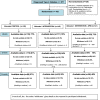Effects of the Norfolk diabetes prevention lifestyle intervention (NDPS) on glycaemic control in screen-detected type 2 diabetes: a randomised controlled trial
- PMID: 34407811
- PMCID: PMC8375190
- DOI: 10.1186/s12916-021-02053-x
Effects of the Norfolk diabetes prevention lifestyle intervention (NDPS) on glycaemic control in screen-detected type 2 diabetes: a randomised controlled trial
Abstract
Background: The purpose of this trial was to test if the Norfolk Diabetes Prevention Study (NDPS) lifestyle intervention, recently shown to reduce the incidence of type 2 diabetes in high-risk groups, also improved glycaemic control in people with newly diagnosed screen-detected type 2 diabetes.
Methods: We screened 12,778 participants at high risk of type 2 diabetes using a fasting plasma glucose and glycosylated haemoglobin (HbA1c). People with screen-detected type 2 diabetes were randomised in a parallel, three-arm, controlled trial with up to 46 months of follow-up, with a control arm (CON), a group-based lifestyle intervention of 6 core and up to 15 maintenance sessions (INT), or the same intervention with additional support from volunteers with type 2 diabetes trained to co-deliver the lifestyle intervention (INT-DPM). The pre-specified primary end point was mean HbA1c compared between groups at 12 months.
Results: We randomised 432 participants (CON 149; INT 142; INT-DPM 141) with a mean (SD) age of 63.5 (10.0) years, body mass index (BMI) of 32.4 (6.4) kg/m2, and HbA1c of 52.5 (10.2) mmol/mol. The primary outcome of mean HbA1c at 12 months (CON 48.5 (9.1) mmol/mol, INT 46.5 (8.1) mmol/mol, and INT-DPM 45.6 (6.0) mmol/mol) was significantly lower in the INT-DPM arm compared to CON (adjusted difference -2.57 mmol/mol; 95% CI -4.5, -0.6; p = 0.007) but not significantly different between the INT-DPM and INT arms (-0.55 mmol/mol; 95% CI -2.46, 1.35; p = 0.57), or INT vs CON arms (-2.14 mmol/mol; 95% CI -4.33, 0.05; p = 0.07). Subgroup analyses showed the intervention had greater effect in participants < 65 years old (difference in mean HbA1c compared to CON -4.76 mmol/mol; 95% CI -7.75, -1.78 mmol/mol) than in older participants (-0.46 mmol/mol; 95% CI -2.67, 1.75; interaction p = 0.02). This effect was most significant in the INT-DPM arm (-6.01 mmol/mol; 95% CI -9.56, -2.46 age < 65 years old and -0.22 mmol/mol; 95% CI -2.7, 2.25; aged > 65 years old; p = 0.007). The use of oral hypoglycaemic medication was associated with a significantly lower mean HbA1c but only within the INT-DPM arm compared to CON (-7.0 mmol/mol; 95% CI -11.5, -2.5; p = 0.003).
Conclusion: The NDPS lifestyle intervention significantly improved glycaemic control after 12 months in people with screen-detected type 2 diabetes when supported by trained peer mentors with type 2 diabetes, particularly those receiving oral hypoglycaemics and those under 65 years old. The effect size was modest, however, and not sustained at 24 months.
Trial registration: ISRCTN34805606 . Retrospectively registered 14.4.16.
Keywords: Diabetes Prevention Mentors; Glycaemic control; Lifestyle Intervention; Peer support; Screen detected; Type 2 diabetes.
© 2021. The Author(s).
Conflict of interest statement
The authors declare that they have no competing interests.
Figures
References
-
- Saeedi P, Petersohn I, Salpea P, Malanda B, Karuranga S, Unwin N, et al. Global and regional diabetes prevalence estimates for 2019 and projections for 2030 and 2045: results from the International Diabetes Federation Diabetes Atlas, 9th edition. Diab Res Clin Pract. 2019;157:107843. doi: 10.1016/j.diabres.2019.107843. - DOI - PubMed
-
- National Institute for Health and Clinical Excellence. Public health draft guidance. Preventing type 2 diabetes: risk identification and interventions for individuals at high risk. National Institute for Health and Clinical Excellence, London; Available from https://www.nice.org.uk/guidance/ph38. 2012. Last accessed 12.2.21
-
- Hemmingsen B, Gimenez-Perez G, Mauricio D, Roqué I Figuls M, Metzendorf MI, Richter B. Diet, physical activity, or both for prevention of delay of type 2 diabetes and its associate complications in people at increased risk of developing type 2 diabetes mellitus. Cochrane Database of Systematic Reviews. 2017; Issue 12 Art No. CD003054 www.cochranelibrary.com (last accessed 4.8.20) - PMC - PubMed
Publication types
MeSH terms
Substances
Associated data
LinkOut - more resources
Full Text Sources
Medical


